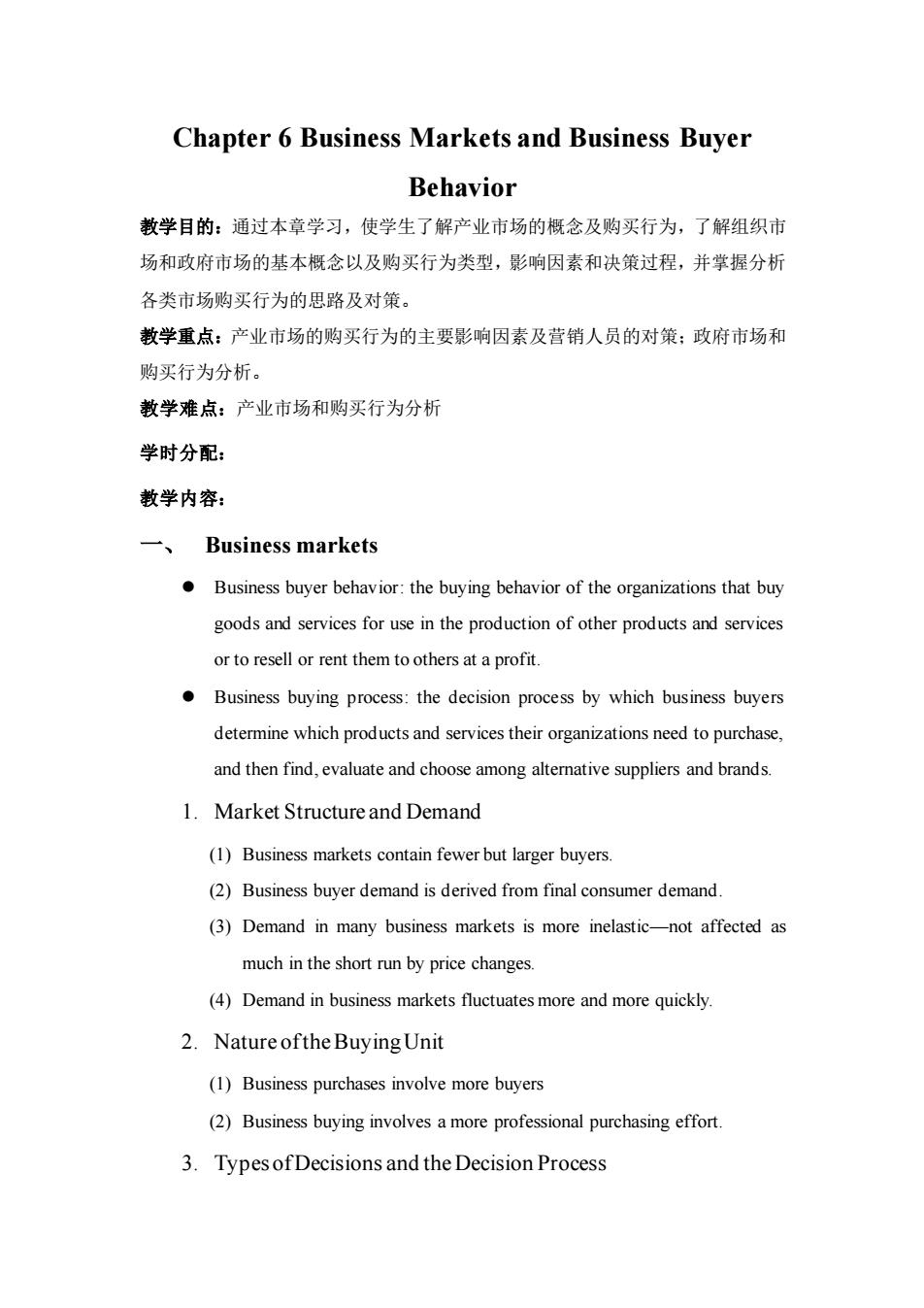
Chapter 6 Business Markets and Business Buyer Behavior 教学目的:通过本章学习,使学生了解产业市场的概念及购买行为,了解组织市 场和政府市场的基本概念以及购买行为类型,影响因素和决策过程,并掌握分析 各类市场购买行为的思路及对策。 教学重点:产业市场的购买行为的主要影响因素及营销人员的对策:政府市场和 购买行为分析。 教学难点:产业市场和购买行为分析 学时分配: 教学内容: 一、Business markets Business buyer behavior:the buying behavior of the organizations that buy goods and services for use in the production of other products and services or to resell or rent them to others at a profit. Business buying process:the decision process by which business buyers determine which products and services their organizations need to purchase, and then find,evaluate and choose among alternative suppliers and brands. 1.Market Structure and Demand (1)Business markets contain fewer but larger buyers. (2)Business buyer demand is derived from final consumer demand. (3)Demand in many business markets is more inelastic-not affected as much in the short run by price changes. (4)Demand in business markets fluctuates more and more quickly. 2.Nature ofthe Buying Unit (1)Business purchases involve more buyers (2)Business buying involves a more professional purchasing effort. 3.TypesofDecisionsand the Decision Process
Chapter 6 Business Markets and Business Buyer Behavior 教学目的:通过本章学习,使学生了解产业市场的概念及购买行为,了解组织市 场和政府市场的基本概念以及购买行为类型,影响因素和决策过程,并掌握分析 各类市场购买行为的思路及对策。 教学重点:产业市场的购买行为的主要影响因素及营销人员的对策;政府市场和 购买行为分析。 教学难点:产业市场和购买行为分析 学时分配: 教学内容: 一、 Business markets ⚫ Business buyer behavior: the buying behavior of the organizations that buy goods and services for use in the production of other products and services or to resell or rent them to others at a profit. ⚫ Business buying process: the decision process by which business buyers determine which products and services their organizations need to purchase, and then find, evaluate and choose among alternative suppliers and brands. 1. Market Structure and Demand (1) Business markets contain fewer but larger buyers. (2) Business buyer demand is derived from final consumer demand. (3) Demand in many business markets is more inelastic—not affected as much in the short run by price changes. (4) Demand in business markets fluctuates more and more quickly. 2. Nature of the Buying Unit (1) Business purchases involve more buyers (2) Business buying involves a more professional purchasing effort. 3. Types of Decisions and the Decision Process
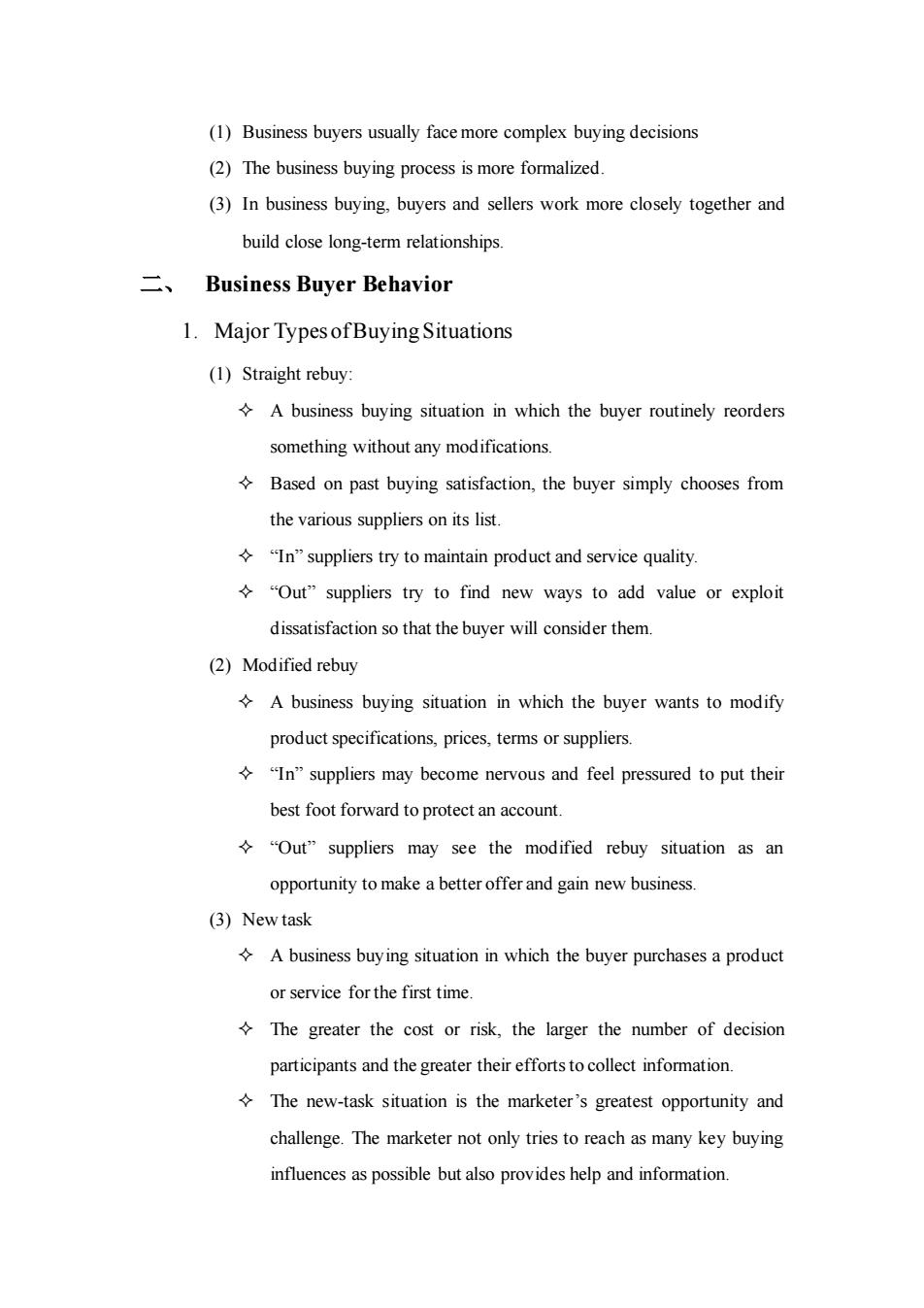
(1)Business buyers usually face more complex buying decisions (2)The business buying process is more formalized. (3)In business buying,buyers and sellers work more closely together and build close long-term relationships. 二、Business Buyer Behavior 1.Major TypesofBuying Situations (1)Straight rebuy: A business buying situation in which the buyer routinely reorders something without any modifications. Based on past buying satisfaction,the buyer simply chooses from the various suppliers on its list. "In"suppliers try to maintain product and service quality. ◆“Out”suppliers try to find new ways to add value or exploit dissatisfaction so that the buyer will consider them (2)Modified rebuy A business buying situation in which the buyer wants to modify product specifications,prices,terms or suppliers "In"suppliers may become nervous and feel pressured to put their best foot forward to protect an account. "Out"suppliers may see the modified rebuy situation as an opportunity to make a better offer and gain new business. (3)New task A business buying situation in which the buyer purchases a product or service for the first time. The greater the cost or risk,the larger the number of decision participants and the greater their efforts to collect information. The new-task situation is the marketer's greatest opportunity and challenge.The marketer not only tries to reach as many key buying influences as possible but also provides help and information
(1) Business buyers usually face more complex buying decisions (2) The business buying process is more formalized. (3) In business buying, buyers and sellers work more closely together and build close long-term relationships. 二、 Business Buyer Behavior 1. Major Types of Buying Situations (1) Straight rebuy: A business buying situation in which the buyer routinely reorders something without any modifications. Based on past buying satisfaction, the buyer simply chooses from the various suppliers on its list. “In” suppliers try to maintain product and service quality. “Out” suppliers try to find new ways to add value or exploit dissatisfaction so that the buyer will consider them. (2) Modified rebuy A business buying situation in which the buyer wants to modify product specifications, prices, terms or suppliers. “In” suppliers may become nervous and feel pressured to put their best foot forward to protect an account. “Out” suppliers may see the modified rebuy situation as an opportunity to make a better offer and gain new business. (3) New task A business buying situation in which the buyer purchases a product or service for the first time. The greater the cost or risk, the larger the number of decision participants and the greater their efforts to collect information. The new-task situation is the marketer’s greatest opportunity and challenge. The marketer not only tries to reach as many key buying influences as possible but also provides help and information
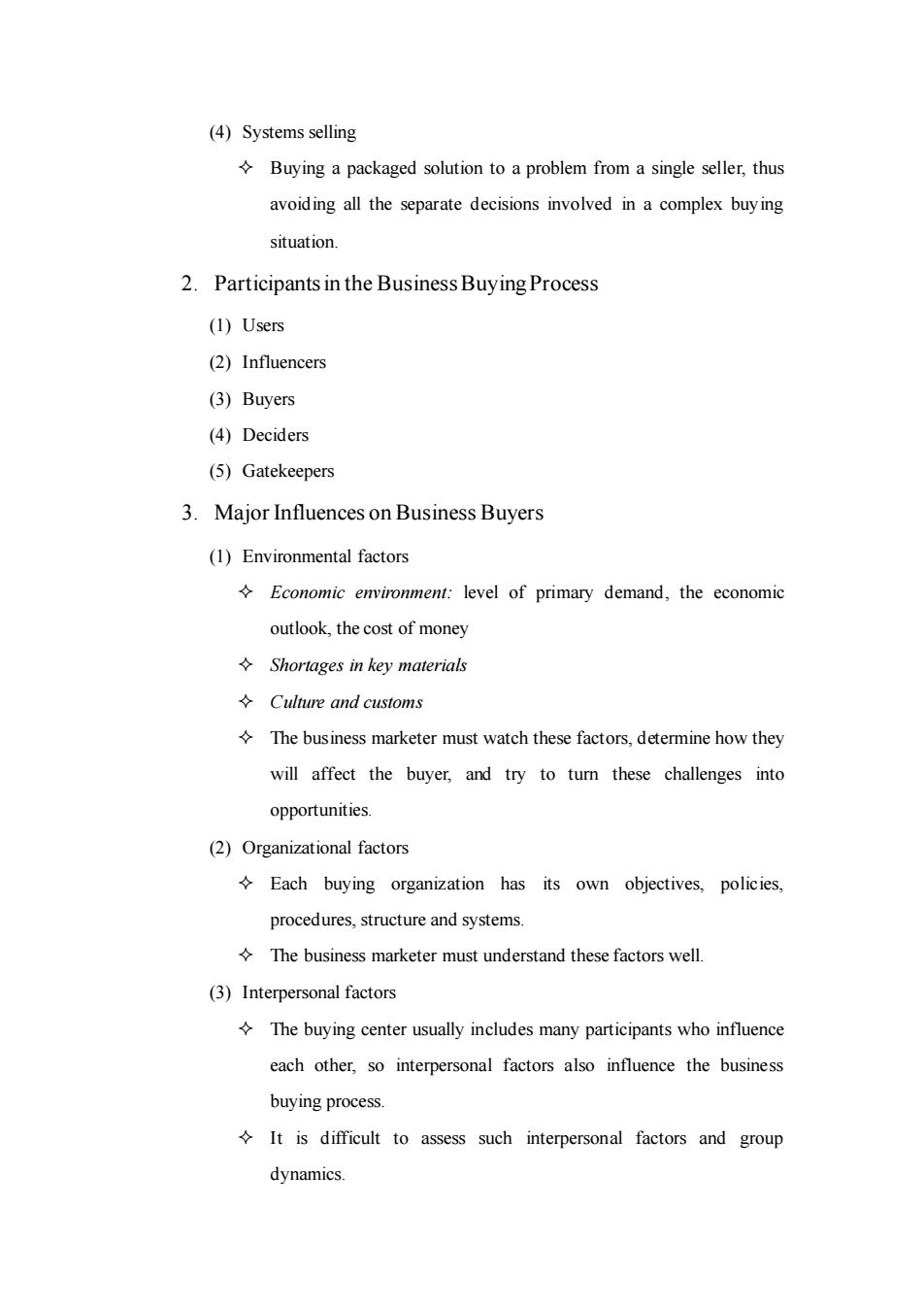
(4)Systems selling Buying a packaged solution to a problem from a single seller,thus avoiding all the separate decisions involved in a complex buying situation. 2.Participants in the Business Buying Process (1)Users (2)Influencers (3)Buyers (4)Deciders (⑤)Gatekeepers 3.Major Influences on Business Buyers (1)Environmental factors Economic environment:level of primary demand,the economic outlook,the cost of money Shortages in key materials 令Culture and customs The business marketer must watch these factors,determine how they will affect the buyer,and try to turn these challenges into opportunities. (2)Organizational factors Each buying organization has its own objectives,policies procedures,structure and systems. The business marketer must understand these factors well. (3)Interpersonal factors The buying center usually includes many participants who influence each other,so interpersonal factors also influence the business buying process. It is difficult to assess such interpersonal factors and group dynamics
(4) Systems selling Buying a packaged solution to a problem from a single seller, thus avoiding all the separate decisions involved in a complex buying situation. 2. Participants in the Business Buying Process (1) Users (2) Influencers (3) Buyers (4) Deciders (5) Gatekeepers 3. Major Influences on Business Buyers (1) Environmental factors Economic environment: level of primary demand, the economic outlook, the cost of money Shortages in key materials Culture and customs The business marketer must watch these factors, determine how they will affect the buyer, and try to turn these challenges into opportunities. (2) Organizational factors Each buying organization has its own objectives, policies, procedures, structure and systems. The business marketer must understand these factors well. (3) Interpersonal factors The buying center usually includes many participants who influence each other, so interpersonal factors also influence the business buying process. It is difficult to assess such interpersonal factors and group dynamics
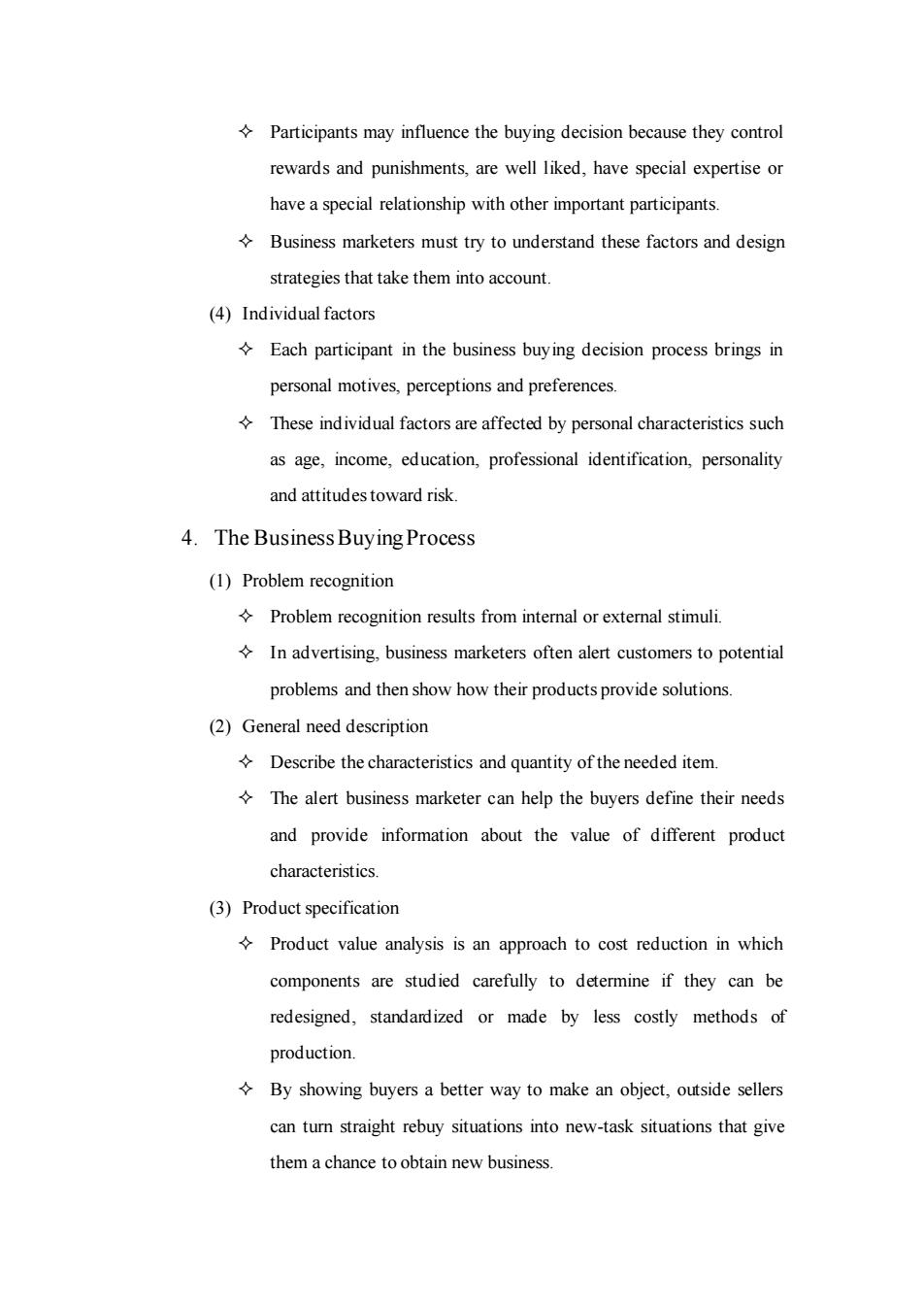
Participants may influence the buying decision because they control rewards and punishments,are well liked,have special expertise or have a special relationship with other important participants. Business marketers must try to understand these factors and design strategies that take them into account. (4)Individual factors Each participant in the business buying decision process brings in personal motives,perceptions and preferences. These individual factors are affected by personal characteristics such as age,income,education,professional identification,personality and attitudestoward risk. 4.The Business Buying Process (1)Problem recognition Problem recognition results from interal or extemal stimul In advertising,business marketers often alert customers to potential problems and then show how their products provide solutions (2)General need description Describe the characteristics and quantity ofthe needed item. The alert business marketer can help the buyers define their needs and provide information about the value of different product characteristics (3)Product specification Product value analysis is an approach to cost reduction in which components are studied carefully to determine if they can be redesigned,standardized or made by less costly methods of production. By showing buyers a better way to make an object,outside sellers can tur straight rebuy situations into new-task situations that give them a chance to obtain new business
Participants may influence the buying decision because they control rewards and punishments, are well liked, have special expertise or have a special relationship with other important participants. Business marketers must try to understand these factors and design strategies that take them into account. (4) Individual factors Each participant in the business buying decision process brings in personal motives, perceptions and preferences. These individual factors are affected by personal characteristics such as age, income, education, professional identification, personality and attitudes toward risk. 4. The Business Buying Process (1) Problem recognition Problem recognition results from internal or external stimuli. In advertising, business marketers often alert customers to potential problems and then show how their products provide solutions. (2) General need description Describe the characteristics and quantity of the needed item. The alert business marketer can help the buyers define their needs and provide information about the value of different product characteristics. (3) Product specification Product value analysis is an approach to cost reduction in which components are studied carefully to determine if they can be redesigned, standardized or made by less costly methods of production. By showing buyers a better way to make an object, outside sellers can turn straight rebuy situations into new-task situations that give them a chance to obtain new business
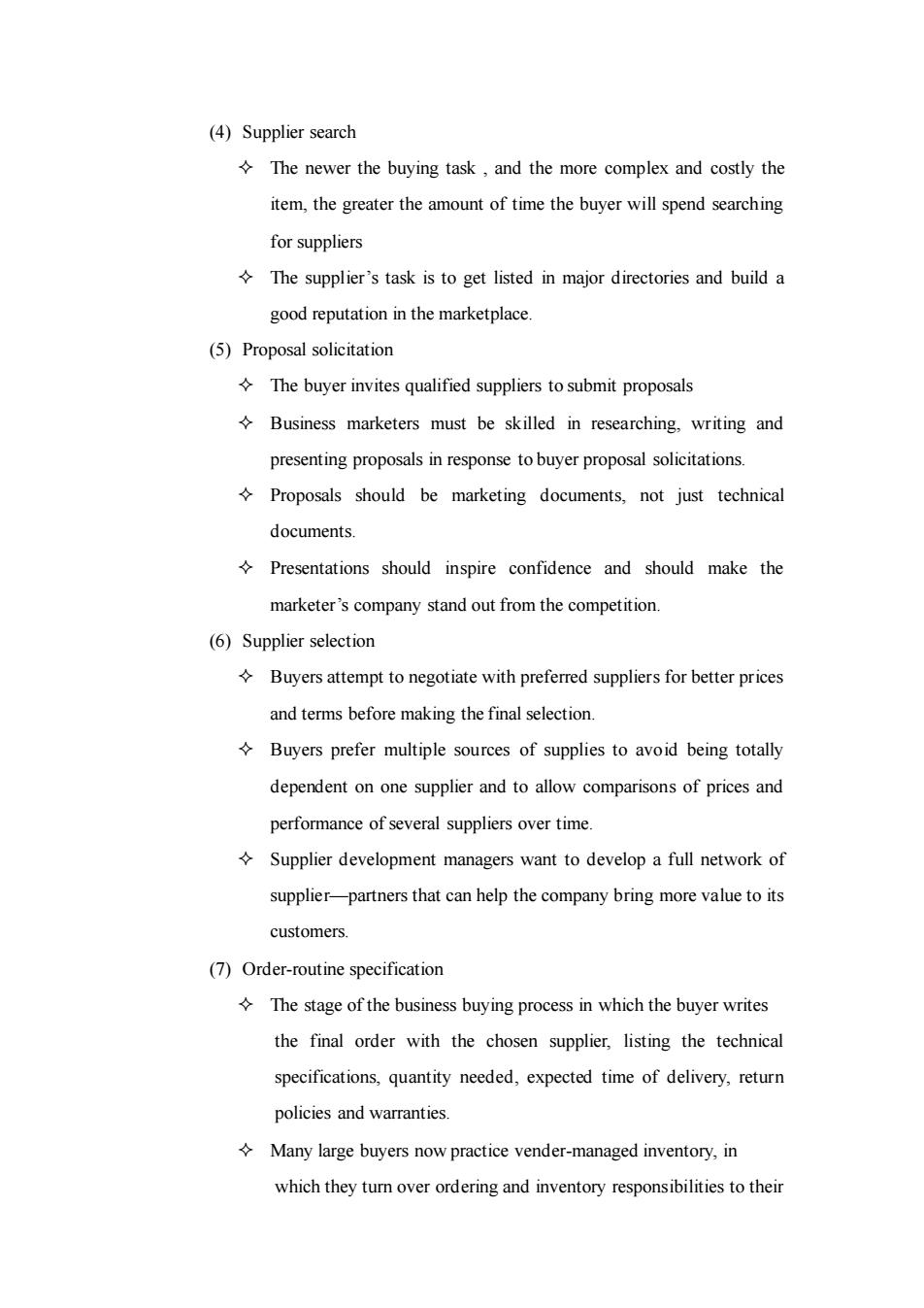
(4)Supplier search The newer the buying task,and the more complex and costly the item,the greater the amount of time the buyer will spend searching for suppliers The supplier's task is to get listed in major directories and build a good reputation in the marketplace. (5)Proposal solicitation The buyer invites qualified suppliers to submit proposals Business marketers must be skilled in researching,writing and presenting proposals in response to buyer proposal solicitations. Proposals should be marketing documents,not just technical documents. Presentations should inspire confidence and should make the marketer's company stand out from the competition (6)Supplier selection Buyers attempt to negotiate with preferred suppliers for better prices and terms before making the final selection. Buyers prefer multiple sources of supplies to avoid being totally dependent on one supplier and to allow comparisons of prices and performance of several suppliers over time. Supplier development managers want to develop a full network of supplier-partners that can help the company bring more value to its customers. (7)Order-routine specification The stage of the business buying process in which the buyer writes the final order with the chosen supplier,listing the technical specifications,quantity needed,expected time of delivery,return policies and warranties. Many large buyers now practice vender-managed inventory,in which they tumn over ordering and inventory responsibilities to their
(4) Supplier search The newer the buying task , and the more complex and costly the item, the greater the amount of time the buyer will spend searching for suppliers The supplier’s task is to get listed in major directories and build a good reputation in the marketplace. (5) Proposal solicitation The buyer invites qualified suppliers to submit proposals Business marketers must be skilled in researching, writing and presenting proposals in response to buyer proposal solicitations. Proposals should be marketing documents, not just technical documents. Presentations should inspire confidence and should make the marketer’s company stand out from the competition. (6) Supplier selection Buyers attempt to negotiate with preferred suppliers for better prices and terms before making the final selection. Buyers prefer multiple sources of supplies to avoid being totally dependent on one supplier and to allow comparisons of prices and performance of several suppliers over time. Supplier development managers want to develop a full network of supplier—partners that can help the company bring more value to its customers. (7) Order-routine specification The stage of the business buying process in which the buyer writes the final order with the chosen supplier, listing the technical specifications, quantity needed, expected time of delivery, return policies and warranties. Many large buyers now practice vender-managed inventory, in which they turn over ordering and inventory responsibilities to their